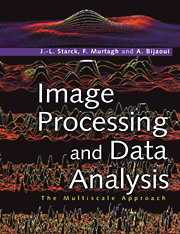Book contents
- Frontmatter
- Contents
- Preface
- 1 The wavelet transform
- 2 Multiresolution support and filtering
- 3 Deconvolution
- 4 1D signals and Euclidean data analysis
- 5 Geometric registration
- 6 Disparity analysis in remote sensing
- 7 Image compression
- 8 Object detection and point clustering
- 9 Multiscale vision models
- APPENDIX A Variance stabilization
- APPENDIX B Software information
- APPENDIX C Acronyms
- Bibliography
- Index
8 - Object detection and point clustering
Published online by Cambridge University Press: 30 October 2009
- Frontmatter
- Contents
- Preface
- 1 The wavelet transform
- 2 Multiresolution support and filtering
- 3 Deconvolution
- 4 1D signals and Euclidean data analysis
- 5 Geometric registration
- 6 Disparity analysis in remote sensing
- 7 Image compression
- 8 Object detection and point clustering
- 9 Multiscale vision models
- APPENDIX A Variance stabilization
- APPENDIX B Software information
- APPENDIX C Acronyms
- Bibliography
- Index
Summary
A pyramidal or other multiresolution representation of an image can be used to facilitate the extraction of information from an image. Imposing a certain ‘syntax’ on the image in this way may be of aid to the user in regard to the image's ‘semantics’: i.e. a structuring imposed on the image may help in interpretation of the image.
For large objects in an image, a well-resolved galaxy for example, or for superimposed objects, a multiscale approach is a very plausible one. Such an approach has been pursued in Bijaoui (1991a, 1993a,b), Bijaoui et al. (1994a), Bijaoui, Slezak and Mars (1989), Slezak et al. (1990, 1993).
Here we consider the case of images with sparsely located, small astronomical objects. For search and analysis of a particular class of objects, we use one privileged scale of a multiresolution transform. An object ‘map’ or boolean image may be derived from the multiresolution support. Such a boolean image may be further cleaned of detector faults, and unwanted objects, using mathematical morphology (or Minkowski) operators.
The problem and the data
Earlier work on our part aimed at finding faint edge-on galaxies in WF/PC images. For each object found, properties such as number of pixels in the object, peak-to-minimum intensity difference, a coefficient characterizing the azimuthal profile, and the principal axis ellipticity, were used to allow discrimination between potentially relevant objects, on the one hand, and faint stars or detector faults, on the other hand.
Information
- Type
- Chapter
- Information
- Image Processing and Data AnalysisThe Multiscale Approach, pp. 231 - 242Publisher: Cambridge University PressPrint publication year: 1998
